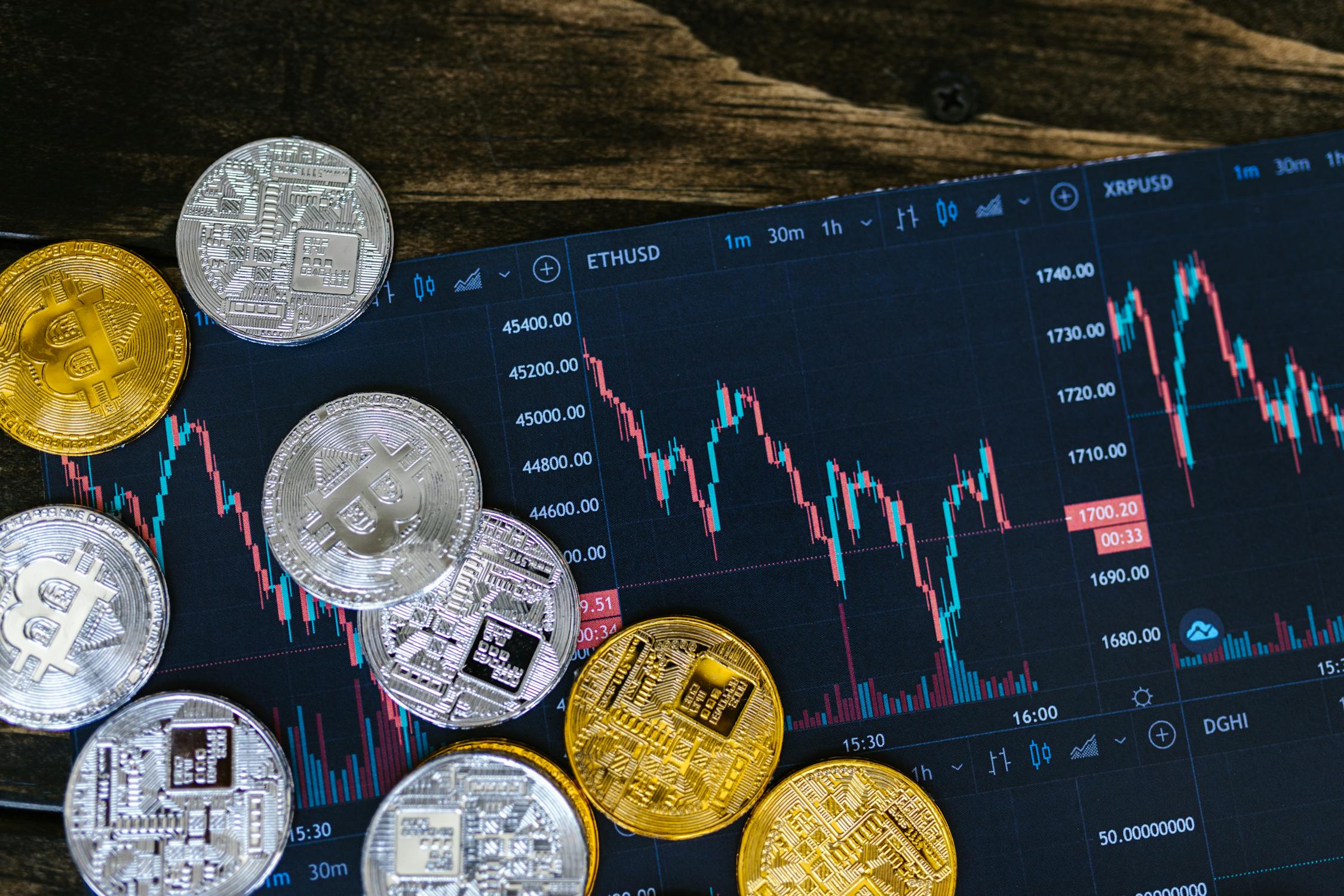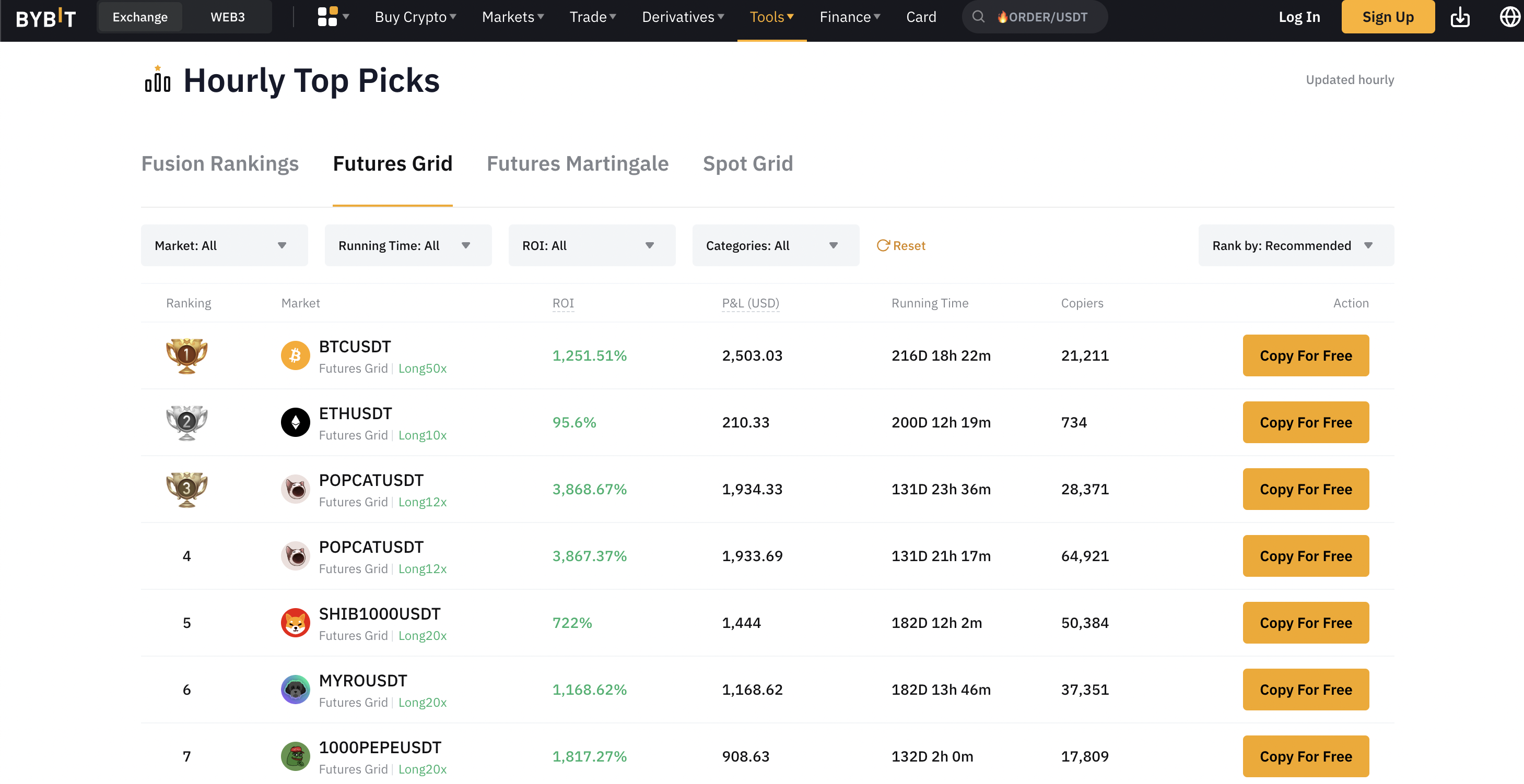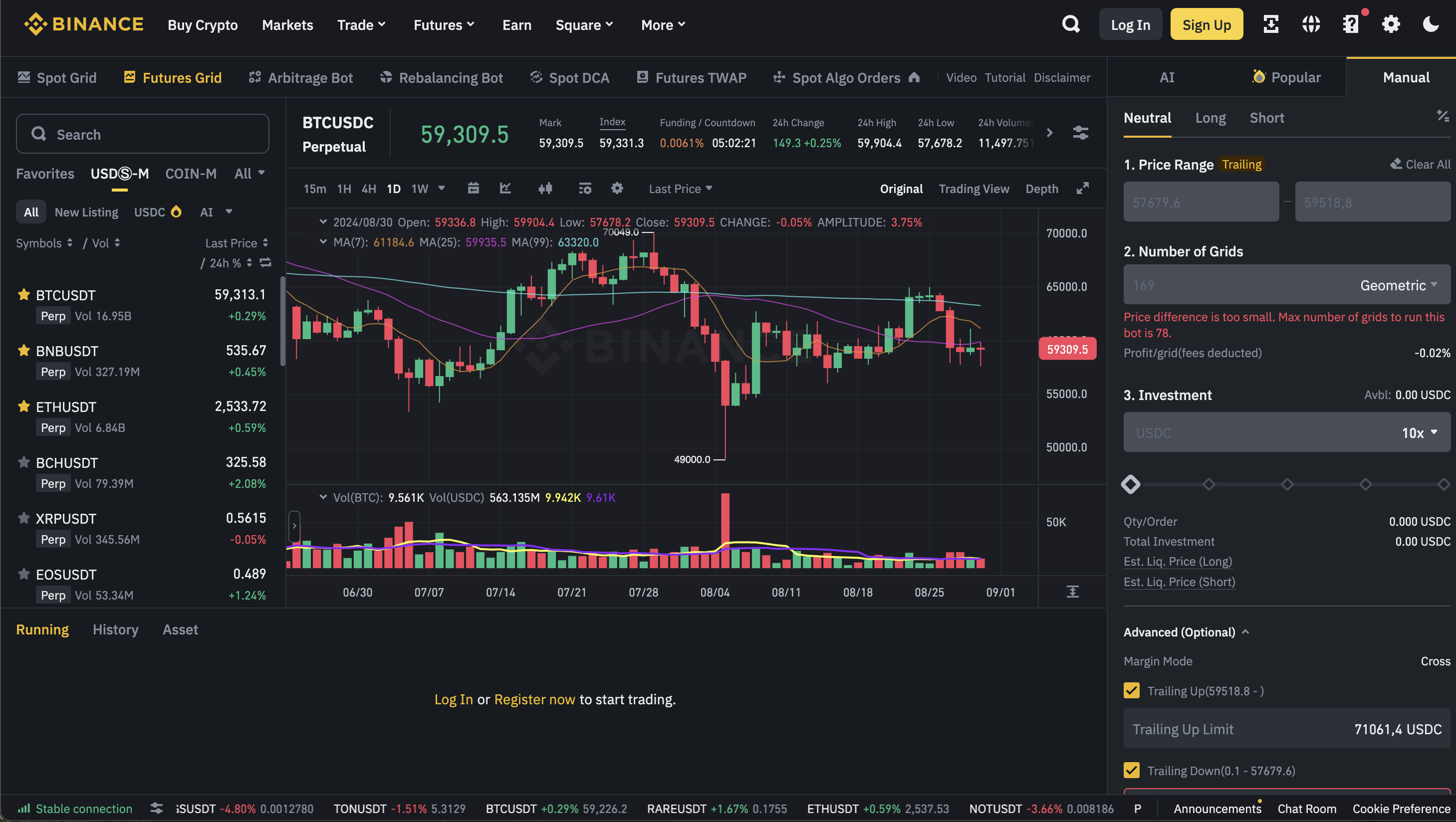Grid trading is a tried-and-tested strategy for the crypto market. It offers a structured approach to harness the asset class’s inherent volatility.
In this guide, we provide a comprehensive overview of crypto grid trading. We explain how the strategy works, explore various approaches, and share optimization tips. Read on to get started with a risk-averse grid strategy.
Here are the most important points about crypto grid trading:Grid Trading For Crypto Investors – Key Takeaways
What is Grid Trading?
Grid trading is a systematic strategy designed to profit from the natural volatility of financial markets. It thrives on the natural ups and downs of crypto. This way, you can profit from volatility without predicting the market’s next big move.
Imagine that your chosen crypto is trading in a fixed price range. In this strategy, you place buy and sell orders at different price levels. These different price levels are called ‘grids.’ As the market fluctuates, the strategy automatically executes trades when the price hits these levels.

This strategy is defined by the number of grids and the gap between them. As the price moves to these grids, more buy and sell orders are triggered. This continuous process allows for ongoing profit opportunities in the volatile crypto market.
How Grid Trading Works in Crypto Markets?
Crypto is inherently volatile, meaning grid trading is well-suited for this market. This section explains how the strategy works in a range-bound market with a relatable example.
We’ll say that Bitcoin is trading at around $50,000. Here’s how you could set up a grid trading strategy:
Define the Number of Grids
Based on the historical price movement, you expect the Bitcoin price to range between $45,000 and $55,000. You decide to set up 10 grid levels at intervals of $1,000.
The grids would be at the following price levels:
- $45,000
- $46,000
- $47,000
- $48,000
- $49,000
- $50,000
- $51,000
- $52,000
- $53,000
- $54,000
Place Buy and Sell Orders
After identifying the grid levels, you’ll place buy and sell orders. For each grid level, a buy order is placed below, and a sell order is placed above the current price. As the market price fluctuates, these orders will be triggered, allowing you to buy low and sell high.
In this example, your grid will look like this.
- Buy orders: $45,000, $46,000, $47,000, $48,000, $49,000
- Sell orders: $51,000, $52,000, $53,000, $54,000, $55,000
If Bitcoin’s price drops to $49,000, the first buy order is triggered. If the price rises to $51,000, the first sell order is executed, generating a $2,000 profit per Bitcoin traded. This process continues as the price moves within the grid range.
Risk Management
For risk management, you should deploy take-profit and stop-loss orders as a minimum requirement.
- Stop-loss – If the Bitcoin price falls below the grid range, you might encounter losses. Therefore, you can consider placing a stop-loss just below the lower boundary of your grid. This could be at $44,500 or $44,000, depending on your risk level.
- Taking profit – As the price approaches and potentially exceeds $55,000, consider taking profits on your existing positions. This allows you to lock in gains within the original grid range before the price moves too far out of it.
- Readjusting the grid – If the price moves significantly above $55,000 or below $45,000, it may be beneficial to readjust your grid. This means establishing a new range that aligns with the current market conditions.
For example, if Bitcoin moves to $58,000, you could set a new grid from $53,000 to $63,000. This adjustment ensures that your grid captures profits in the new price range.
The example above pertains to the classic grid strategy. However, different variations are available for other trading styles – more on that below.
Types of Grid Trading
Grid trading is versatile and can be adapted to different market conditions. Below, we outline the most popular crypto grid trading strategies. Read on to choose the right strategy for you.
Classic Grid Trading
Classic grid trading is the most straightforward option. It involves placing a series of buy and sell orders at regular intervals above and below the current market price.
This version is suitable for markets with no particular trend. Instead, they’re range-bound. The strategy makes profits when the market moves within the range. It also requires minimal market analysis.
Trend Grid Trading
As the name suggests, this grid trading strategy is used when markets have a clear trend. It involves placing buy and sell orders that align with the price movement.
- For bullish markets – Buy orders are placed at grids above the current price. And sell orders (to take profit) are placed at even higher levels.
- For bearish markets – Sell orders are placed at intervals below the current price. Consequently, buy orders are placed at even lower levels. In this approach, you’ll be shorting the respective crypto.
This strategy aims to capitalize on the trend continuation, not price reversals.
For instance, let’s say Ethereum is witnessing a downtrend, with a current market price of $2,000.
- In this strategy, you would place sell orders at $1,950, $1,900, $1,850, $1,800, etc.
- And buy orders would be placed at corresponding levels below these sell orders, such as $1,600, $1,650, $1,700, $1,750, etc.
As the Ethereum price continues to decline, your sell orders will be triggered, allowing you to sell at favorable levels. As the price drops further and hits your buy levels – you purchase Ethereum at a lower price. Thereby, you lock in profits from the difference.
Martingale Grid Trading
This strategy combines the classic grid and Martingale approaches. It involves doubling the trade size after every loss. The concept is that eventually, one of the trades will be profitable. Once a winning trade is secured, it will not only retrieve the previous losses but also yield a gain. This strategy has a high-profit potential but vastly increases the risk of significant losses.

What’s more, traders should also have access to significant capital to run this strategy successfully. After all, each losing trade requires double the stake on the next position. As such, this strategy is often used for crypto futures. This is because you can use leverage to open larger positions with less upfront capital. Additionally, futures can be traded long and short, enhancing flexibility.
Anti-Martingale Grid Trading
In Anti-Martingale grid trading, instead of increasing trade size after a loss, you boost it after a win. This way, you capitalize on so-called winning streaks.
Sometimes, the strategy also involves reducing the position size after a loss. This further limits the overall risk. Therefore, this grid strategy is more suitable for conservative traders. However, do note it’s more effective in trending markets, where upward/downward cycles are more likely to continue.
Advantages of a Grid Trading Strategy for Crypto Investors
Below, we discuss the benefits of grid trading, and why this strategy is increasingly being used by seasoned crypto investors.
A Great Strategy Option for Beginners
At its core, grid trading is relatively simple to execute. You don’t need to analyze your chosen crypto, understand its valuation, growth drivers, etc. Similarly, it’s not necessary to be an expert in technical analysis.
While indicators can help refine your grid set-up, they’re not essential to the strategy’s success. The focus is on capturing profits from price movements rather than predicting them. Furthermore, once the grid levels are set, the strategy theoretically runs without manual intervention.
Can be Personalized
Grid trading can be personalized to suit individual trading preferences. Users can choose the number of grids and the gap between them. This allows for precise control over trading frequency and the size of potential profits.
- For instance, a tighter grid can be used for more frequent, smaller trades in a heavily volatile market.
- On the other hand, a wider grid for fewer, larger trades in a stable market.
You can also combine grid trading with other tools like stop-loss orders or technical indicators. This flexibility makes grid trading adaptable to various risk appetites.
Less Emotional Decision-Making
Another advantage of grid trading is its power to reduce emotional decision-making. Oftentimes, human traders make impulsive decisions as the market changes its behavior. Grid trading, on the other hand, helps you maintain a systematic approach.
Once the grid is set, trades are executed according to pre-determined rules. This leaves very little room for rash decisions. It can therefore lead to more consistent and rational trading outcomes.
Scalability Across Multiple Cryptos
Grid trading can be applied to virtually any crypto market. This enables investors to create a diversified crypto portfolio. For each coin, the grid parameters can be changed depending on the respective liquidity levels and price action.
Moreover, by using grid trading bots, the strategy can be scaled to multiple crypto pairs simultaneously. This reduces the overall risk and gives the potential for more profits.
Adaptable to Different Market Conditions
Grid trading is highly adaptable to various market conditions. As discussed, there are many types of grid trading strategies that can be deployed. This means grid trading is no longer limited to just range-bound markets. Instead, it can also be used in trending landscapes.
Moreover, trading grids are also adjustable based on the preferred risk level. This adaptability ensures that grid trading remains effective for different investor profiles.
Here are some reasons why grid trading is viable for both novice and seasoned crypto traders.Why Trading Grid is a Smart Choice for New and Experienced Traders
Crypto Grid Trading – Spot vs Derivatives Market
The crypto market is broadly classified into spot and derivative trading. Crucially, the grid strategy works for both. However, each market offers distinct advantages and drawbacks. Therefore, it’s essential to understand their differences when implementing a grid trading strategy.
Grid Trading in the Crypto Spot Market
The crypto spot markets are straightforward. You trade the underlying crypto directly, and asset ownership is transferred immediately upon closing the position. For example, you currently hold Bitcoin and trade the BTC/USDT pair. This means you’ve swapped Bitcoin for USDT. As such, conventional grid trading involves buying and selling the actual cryptocurrency at current market prices.

The advantage here is the simplicity, with transactions being settled immediately. However, you’ll need to commit the full amount of crypto required for each trade. This can require substantial capital, considering grid strategy requires multiple buy/sell orders. However, you won’t be trading with leverage, so this eliminates the liquidation risk.
Grid Trading of Crypto Derivatives
In the derivatives market, grid trading involves trading contracts representing the underlying crypto. In other words, you won’t be buying or selling the actual coins. There are different types of crypto derivatives available – such as CFDs, delivery futures, perpetual futures, and options.
The crypto derivatives market offers significant advantages for grid trading. This includes high leverage levels. Leverage allows traders to control larger positions with a smaller initial capital investment. This amplifies potential profits from the grid strategy.
Furthermore, the ability to trade on margin reduces the need for a total capital commitment. Crypto derivatives are also suitable for short selling. This enables traders to profit from both rising and falling markets. This flexibility is essential for grid trading, which thrives on market volatility.
Best Platforms for Crypto Grid Trading
To run a successful grid trading strategy, you need a suitable exchange. The chosen platform should offer high liquidity, low fees, and support for your preferred trading pairs. What’s more, consider whether the exchange offers spot trading and/or leveraged derivatives.
Read on to discover the best platforms for crypto grid trading.
1. ByBit – Trade Crypto Futures Grid With Up to 100x Leverage
Bybit has emerged as a leading crypto exchange since its launch in 2018. It offers a comprehensive platform for both spot and derivatives trading. The exchange supports thousands of crypto pairs and provides access to margin, futures, and options markets. If you’re trading grid strategies manually, you can adjust the risk by using a variety of order types – including conditional, OCO, iceberg, etc.
ByBit also offers dedicated trading bots for different strategies. For example, ByBit’s spot grid bots claim APRs as high as 595,351%. For the futures grid bot, users can get leverage of up to 100x. The highest APR for futures bots comes to 78,005,989%. Furthermore, ByBit has an AI algorithm that recommends the best trading bots based on weekly performance.

With ByBit, you can create a grid bot or copy another trader’s strategy. Coming to fees, the platform follows a maker-taker structure. Spot trades incur a commission of up to 0.10%. Futures and perpetual contracts cost up to 0.05%. Moreover, ByBit discounts fees for higher trading volumes – which could work well for the grid strategy.
Pros:
Cons:
2. AvaTrade – Trade Crypto CFDs With 0% Commission
AvaTrade is a regulated brokerage supporting multi-asset trading. It holds licenses in nine jurisdictions and has a strong reputation in the industry. AvaTrade offers cryptocurrencies via CFDs. These derivatives let you trade crypto without owning any coins.
You can trade 16 leading cryptocurrencies – including Bitcoin, Ethereum, Dash, Uniswap, and Litecoin. The crypto positions can also be leveraged up to 20x. However, low limits are offered in some countries. For grid trading, you can access multiple order types, including stop-losses for risk management. Alternatively, you can also copy grid trading strategies set up by other users.

Copy trading can be done via AvaTrade’s social trading platforms – DupliTrade and AvaSocial. AvaTrade’s fee structure is also suitable for grid traders. It has a 0% commission policy and charges a competitive spread. Moreover, the minimum deposit requirement is just $100. AvaTrade supports debit/credit cards, bank wires, and other convenient payment types.
Pros:
Cons:
3. Binance – Create Grid Trading Strategies From Scratch
Binance needs no introduction to crypto traders. As the world’s largest cryptocurrency exchange, it offers extensive support for grid trading. Binance allows users to set up grid trading strategies directly within their accounts. You can also automate the strategy with Binance bots.
Simply specify the number of grids, the price range, and the amount to invest per trade. Once these settings are configured, the bot automatically executes trades as prices fluctuate within the grid. There are also traditional and trailing stop-loss orders to manage risk.

Customizable predesigned grid bots are also available. Binance offers grid trading tools for free. However, there’s a commission for each position entered, which goes up to 0.10% for spot trading. For crypto derivatives, the commission can be as high as 0.05% per trade. These commissions are reducible with higher trading volumes.
Pros:
Cons:
4. Crypto.com – Trade 300+ Crypto Pairs With the Grid Strategy
Crypto.com is another popular platform catering to grid traders. It comes with a powerful trading terminal with advanced indicators and charting tools. The platform supports 300+ crypto pairs. It also features a margin trading dashboard with 200+ pairs and leverage of up to 10x.
Crypto.com also supports manual and automated grid trading. If using bots, you can filter them based on potential return per grid and the respective crypto pair. Traders can create bots with their preferred price range, number of grids, and investment amount. These tools can be accessed on the Crypto.com website and its native mobile apps.

However, Crypto.com only supports BTC/USD and ETH/USD when trading futures. Moreover, there are no futures bots available. Crypto.com charges up to 0.15% for market makers. For takers, the commission goes up to 0.2640%. The cost can be reduced by holding CRO tokens or by increasing trading volumes.
Pros: Cons: Last on our list is Pionex, a popular crypto exchange supporting passive trading tools. For grid traders, Pionex lets you create your own strategies by defining parameters. There are also multiple order types available for customization. However, Pionex’s strength lies in its predefined bots. It offers leveraged, Martingale, reverse, and infinity strategies. All prebuilt bots are customizable, offering traders more control over the strategy. What’s more, Pionex features highly liquid spot and futures markets suitable for grid trading. Regarding fees, Pionex spot trades are charged a 0.05% commission for both makers and takers. When trading futures, market makers pay just 0.02% commission. As with other exchanges, users with high trading volumes can avail of a discount. Pros: Cons:
Grid trading profits from market fluctuations by design. However, careful adjustments can enhance its effectiveness. Here are seven ways to optimize your grid trading strategy. The first step is to select the right crypto pair for grid trading. Not all crypto pairs behave the same. While some are highly volatile, others may exhibit more stable price movements. The efficacy of grid trading hinges on the pair’s volatility. This means it’s often best to choose a crypto pair with reasonable volatility to trigger your grid levels regularly. However, the price movements shouldn’t be too erratic to disrupt your strategy. Pairs with consistent volume and liquidity are ideal, as they ensure smoother execution of trades. If you’re a beginner, consider starting with well-established pairs like BTC/USDT or ETH/USDT. These offer a good balance between volatility and stability. Experienced traders might explore more volatile pairs to maximize potential profits. But bear in mind that this adds more risk. The next step is to select an appropriate grid range. This should cover the price levels where you expect the crypto pair to fluctuate. To define the grid range, you can use support and resistance levels. This can be done by analyzing past price points where the crypto consistently reverses direction. Alternatively, you can also use technical indicators such as Moving Average or Fibonacci Retracement. Grid size and spacing between levels are also critical to your strategy’s success. Also, consider trading fees. Frequent small trades could result in more commission and eat into your profit. While grid trading doesn’t require indicators, using them can help optimize your strategy. Indicators like Moving Averages, RSI (Relative Strength Index), or Bollinger Bands can help you set more informed grid levels. For instance, if the RSI indicates a crypto is overbought, it suggests that the price might decline soon. In response, you might adjust your grid levels upwards to capture potential profits from the expected price drop. As mentioned, the Moving Average can be a useful indicator in defining price ranges. Needless to say, crypto trading risk management is pivotal in the grid strategy. Here are some best practices: Without proper risk management, you could face significant losses during unforeseen market conditions. Automated trading bots are taking over the crypto industry. Today, you can find crypto trading bots dedicated to the grid strategy. Using them frees you from manual monitoring. It also ensures consistent execution of your strategy. With fully automated bots, you only need to define the grid range, spacing, and fund allocation. The bot will handle the rest. Some trading bots can even define the best parameters based on market conditions. Moreover, they are also equipped to manage risk without human intervention. Optimizing a grid strategy isn’t a one-time task. Market conditions change, and your grid trading strategy should evolve accordingly. Therefore, regularly check your strategy’s performance. You can track profit/loss ratios, win rates, and average trade duration. In addition, keep up with key market news. After all, this can impact the crypto you’re trading. Despite its advantages, grid trading has some drawbacks that impact its effectiveness. Understanding these limitations is crucial for optimizing your strategy and managing potential risks. Grid trading involves placing a large number of buy and sell orders. Each trade executed within the grid incurs a fee. This can lead to substantial trading costs, especially with high-fee exchanges. Consequently, fees will also diminish your profits. This is particularly true in markets with low liquidity, where there can be high slippage risks. Therefore, grid trading requires careful consideration of the chosen crypto pair and trading platform. Managing multiple positions in a grid trading strategy can be demanding. As the market fluctuates, various buy and sell orders are triggered across different price levels. The complexity also increases with the grid size. Needless to say, all these orders require monitoring. And the complexity can lead to errors or missed opportunities. In other words, managing positions requires an in-depth understanding of the grid’s performance. Grid trading strategies, especially those following the trend, are vulnerable to market reversals. In a trend-following approach, as the price moves in a direction, the grid triggers additional buy or sell orders. This increases the position size and potential profits. This vulnerability emphasizes the importance of having a well-defined exit strategy to manage abrupt market shifts effectively. Undoubtedly, the grid trading strategy is simple and effective. However, as we’ve established, it also requires constant input from the trader. You need to check the grid parameters regularly to align with market conditions. Moreover, it can be challenging to scale the strategy manually. However, these constraints can be addressed by using an automated bot like Algobot. This offers several advantages over manual grid trading. First, Algobot is equipped with an AI algorithm. This means it dynamically chooses the right trading strategies based on the real-time market cycle. Algobot also uses 100+ technical indicators to adjust its trading rules. Moreover, Algobot can trade multiple crypto pairs simultaneously. In addition to crypto, Algobot also supports stocks, forex, indices, and commodities. Above all, Algobot is fully autonomous, freeing you from having to monitor your grid trades. It’s more efficient and consistent, avoiding impulsive trading decisions. Algobot also places risk management orders to minimize the risk. It works with all leading crypto platforms, offering another convenience layer. With Algobot, you’re not limited to the grid strategy. It provides a more sophisticated and flexible approach to trading in various market conditions.
In summary, we’ve offered a comprehensive take on what is grid trading. This strategy offers a systematic approach to the crypto markets. It’s also versatile and lets you capitalize on different market conditions. However, the grid trading strategy also demands careful management and regular adjustments. To ensure success, implement robust risk management tools – such as well-defined take-profit and stop-loss levels. Grid trading is a strategy for executing positions within a defined price range. It involves placing multiple buy and sell orders at set intervals to capitalize on the price fluctuation. Crypto grid trading can be profitable, particularly in volatile markets. However, its success depends on a careful setup, market conditions, and effective risk management. Grid trading could lead to significant losses during sudden market reversals. Additionally, managing multiple positions can be complex and may lead to losses without proper risk management tools. You can optimize grid trading by choosing the right spacing and setting stop-losses. You can also use technical indicators to find the most suitable grid range. Yes, volatility increases the frequency of price movements within the grid levels. It thus generates more trading opportunities and can lead to greater profits.
5. Pionex – Access a Wide Variety of Grid Trading Bots

How to Optimize Grid Trading Strategy
1. Choose the Right Crypto Pair
2. Define the Grid Range
3. Find Grid Size and Spacing
4. Incorporate Technical Indicators

5. Risk Management
6. Use Automated Trading Bots
7. Monitor and Adjust
Drawbacks of Grid Trading
Potentially High Transaction Costs
Complexity in Managing Positions

Vulnerability to Market Reversals
Best Alternative to Grid Trading
The Verdict
FAQs
What is grid trading?
Is crypto grid trading profitable?
What are the risks of grid trading?
How to optimize my grid trading strategy?
Is volatility good for grid trading?








